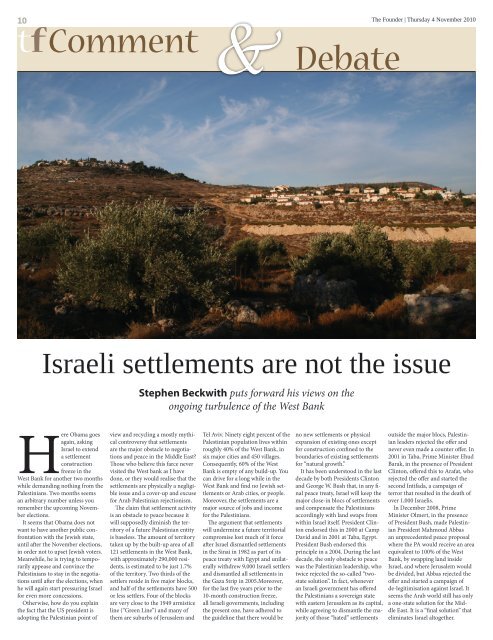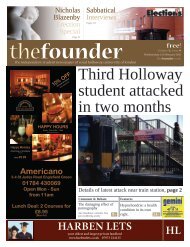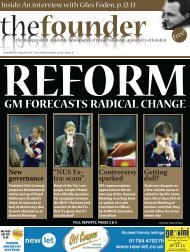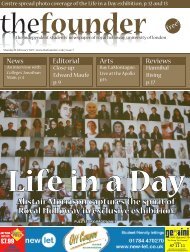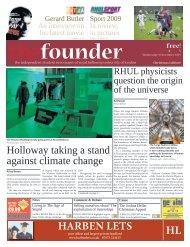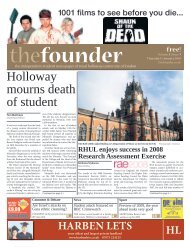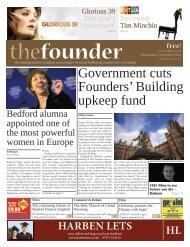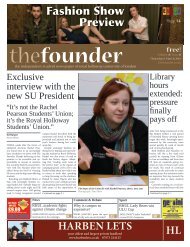The Founder Volume 5 Issue 4
The Founder Volume 5 Issue 4
The Founder Volume 5 Issue 4
You also want an ePaper? Increase the reach of your titles
YUMPU automatically turns print PDFs into web optimized ePapers that Google loves.
10 <strong>The</strong> <strong>Founder</strong> | Thursday 4 November 2010<br />
tfComment<br />
& Debate<br />
Israeli settlements are not the issue<br />
Stephen Beckwith puts forward his views on the<br />
ongoing turbulence of the West Bank<br />
Here Obama goes<br />
again, asking<br />
Israel to extend<br />
a settlement<br />
construction<br />
freeze in the<br />
West Bank for another two months<br />
while demanding nothing from the<br />
Palestinians. Two months seems<br />
an arbitrary number unless you<br />
remember the upcoming November<br />
elections.<br />
It seems that Obama does not<br />
want to have another public confrontation<br />
with the Jewish state,<br />
until after the November elections,<br />
in order not to upset Jewish voters.<br />
Meanwhile, he is trying to temporarily<br />
appease and convince the<br />
Palestinians to stay in the negotiations<br />
until after the elections, when<br />
he will again start pressuring Israel<br />
for even more concessions.<br />
Otherwise, how do you explain<br />
the fact that the US president is<br />
adopting the Palestinian point of<br />
view and recycling a mostly mythical<br />
controversy that settlements<br />
are the major obstacle to negotiations<br />
and peace in the Middle East?<br />
Those who believe this farce never<br />
visited the West bank as I have<br />
done, or they would realise that the<br />
settlements are physically a negligible<br />
issue and a cover-up and excuse<br />
for Arab Palestinian rejectionism.<br />
<strong>The</strong> claim that settlement activity<br />
is an obstacle to peace because it<br />
will supposedly diminish the territory<br />
of a future Palestinian entity<br />
is baseless. <strong>The</strong> amount of territory<br />
taken up by the built-up area of all<br />
121 settlements in the West Bank,<br />
with approximately 290,000 residents,<br />
is estimated to be just 1.7%<br />
of the territory. Two thirds of the<br />
settlers reside in five major blocks,<br />
and half of the settlements have 500<br />
or less settlers. Four of the blocks<br />
are very close to the 1949 armistice<br />
line (“Green Line”) and many of<br />
them are suburbs of Jerusalem and<br />
Tel Aviv. Ninety eight percent of the<br />
Palestinian population lives within<br />
roughly 40% of the West Bank, in<br />
six major cities and 450 villages.<br />
Consequently, 60% of the West<br />
Bank is empty of any build-up. You<br />
can drive for a long while in the<br />
West Bank and find no Jewish settlements<br />
or Arab cities, or people.<br />
Moreover, the settlements are a<br />
major source of jobs and income<br />
for the Palestinians.<br />
<strong>The</strong> argument that settlements<br />
will undermine a future territorial<br />
compromise lost much of it force<br />
after Israel dismantled settlements<br />
in the Sinai in 1982 as part of its<br />
peace treaty with Egypt and unilaterally<br />
withdrew 9,000 Israeli settlers<br />
and dismantled all settlements in<br />
the Gaza Strip in 2005.Moreover,<br />
for the last five years prior to the<br />
10-month construction freeze,<br />
all Israeli governments, including<br />
the present one, have adhered to<br />
the guideline that there would be<br />
no new settlements or physical<br />
expansion of existing ones except<br />
for construction confined to the<br />
boundaries of existing settlements<br />
for “natural growth.”<br />
It has been understood in the last<br />
decade by both Presidents Clinton<br />
and George W. Bush that, in any final<br />
peace treaty, Israel will keep the<br />
major close-in blocs of settlements<br />
and compensate the Palestinians<br />
accordingly with land swaps from<br />
within Israel itself. President Clinton<br />
endorsed this in 2000 at Camp<br />
David and in 2001 at Taba, Egypt.<br />
President Bush endorsed this<br />
principle in a 2004. During the last<br />
decade, the only obstacle to peace<br />
was the Palestinian leadership, who<br />
twice rejected the so-called “twostate<br />
solution”. In fact, whenever<br />
an Israeli government has offered<br />
the Palestinians a sovereign state<br />
with eastern Jerusalem as its capital,<br />
while agreeing to dismantle the majority<br />
of those “hated” settlements<br />
outside the major blocs, Palestinian<br />
leaders rejected the offer and<br />
never even made a counter offer. In<br />
2001 in Taba, Prime Minister Ehud<br />
Barak, in the presence of President<br />
Clinton, offered this to Arafat, who<br />
rejected the offer and started the<br />
second Intifada, a campaign of<br />
terror that resulted in the death of<br />
over 1,000 Israelis.<br />
In December 2008, Prime<br />
Minister Olmert, in the presence<br />
of President Bush, made Palestinian<br />
President Mahmoud Abbas<br />
an unprecedented peace proposal<br />
where the PA would receive an area<br />
equivalent to 100% of the West<br />
Bank, by swapping land inside<br />
Israel, and where Jerusalem would<br />
be divided, but Abbas rejected the<br />
offer and started a campaign of<br />
de-legitimisation against Israel. It<br />
seems the Arab world still has only<br />
a one-state solution for the Middle<br />
East. It is a “final solution” that<br />
eliminates Israel altogether.


